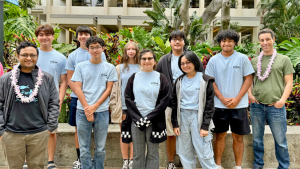
How can you use artificial intelligence (AI) to improve how doctors process and treat patients? That is the challenge that a group of high school students from around the state tackled during a two-week summer course at the University of Hawaiʻi at Mānoa.
Under the guidance of Associate Professor Mahdi Belcaid, the interns from eight Hawaiʻi high schools developed “Parrot Forms,” a system designed to automatically transcribe doctor-patient conversations, extract relevant medical information and populate the details directly into a mockup electronic medical record. This digital assistant aims to reduce paperwork and improve efficiency in medical offices.

Each session began with a short lecture on a topic relevant to the next step of the project, followed by brainstorming, prototyping, coding and debugging sessions. The interns gained valuable skills such as understanding medical processes, including how doctors structure and document patient interactions, modern data representation protocols, engineering accurate prompts, and writing and executing code with ChatGPT.
“These students have shown remarkable aptitude in applying AI to real-world problems,” said Belcaid, who holds a joint appointment in the Department of Information and Computer Sciences (ICS) and Hawaiʻi Institute for Marine Biology (HIMB). “Their work on Parrot Forms demonstrates the potential of AI to transform healthcare documentation, and showcases the spirit of Hawaiʻi’s next generation of tech innovators.”
The students experienced the newest tech in UH Mānoa’s Laboratory of Applications in Informatics and Analytics.
One participant wrote, “This is definitely a career option I might pursue in the future, and I really enjoyed learning about how things operate behind the scenes. I think this is without a doubt the most eye-opening experience career-wise that I’ve had the opportunity to participate in.”
This internship was part of Project Hōkūlani, housed in UH Mānoa’s Center on Disability Studies, College of Education. Its goal is to support Native Hawaiian high school students statewide into science, technology, engineering and math (STEM) fields. This is the third year that Belcaid’s lab has been hosting students through Project Hōkūlani.
“Project Hōkūlani aims to ignite passion for STEM in Hawaiʻi’s youth,” Project Hōkūlani Principal Investigator Hye Jin Park said. “Through hands-on projects like Parrot Forms, we’re preparing students for the tech-driven future and showcasing the innovative potential right here in our islands.”
ICS is housed in the UH Mānoa College of Natural Sciences and HIMB is housed in the UH Mānoa School of Ocean and Earth Science and Technology.

